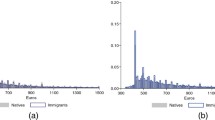Abstract
Models of wage indexation uniformly have been based on the simplifying assumption that nominal wages adjust upward or downwrd symmetrically with unexpected price increases or decreases. Indexation typically is asymmetric in actual contracts, however. Wages are indexed to price increases but not to price reductions. This paper analyzes a macroeconomic model with asymmetric indexation. On the one hand, this paper finds that when stable equilibria supporting use of such asymmetrically indexed contracts exist, the result is an unambiguous downward bias in the base contract wage, because workers must pay a premium for insurance against real wage reductions that unexpected inflation otherwise would induce. On the other hand, the paper concludes that the likelihood of existence of stable equilibria supporting positive wage indexation generally declines as aggregate demand variability rises relative to the variability of aggregate supply. This may help explain why relatively low levels of wage indexation actually are observed in nations with relatively contained aggregate demand volatility.
Similar content being viewed by others
References
Ball, Laurence, “Is Equilibrium Indexation Efficient?”Quarterly Journal of Economics, 103, 2, May 1988, pp. 299–311.
Barro, Robert J. and David Gordon, “A Positive Theory of Monetary Policy in a Natural Rate Model,”Journal of Political Economy, 91, 4, August 1983, pp. 589–610.
Bryson, Jay, Chih-huan Chen, and David VanHoose, “Implications of Economic Interdependence for Endogenous Wage Indexation Decisions,”Scandinavian Journal of Economics, 100, 4, December 1998, pp. 693–710.
Card, David, “An Empirical Model of Wage Indexation Provisions in Union Contracts,”Journal of Political Economy, 94, 3, June 1986, part 2, pp. S144-S175.
Cover, James P., “Asymmetric Effects of Positive and Negative Money Supply Shocks,”Quarterly Journal of Economics, 107, 4, November 1992, pp. 1261–1282.
Duca, John and David VanHoose, “Goods-Market Competition and Profit Sharing: A Multisector Macro Approach,”Journal of Economics and Business, 50, 4, November 1998b, pp. 525–534.
__. “The Rise of Goods-Market Competition and the Decline in Wage Indexation,”Journal of Macroeconomics, 20, 3, Summer 1998a, pp. 579–598.
__. “Optimal Wage Indexation in a Multisector Economy,”International Economic Review, 32, 4, December 1991, pp. 859–867.
Fischer, Stanley, Indexing, Inflation, and Economic Policy: Cambridge, MA: MIT Press, 1986.
__. “Long-Term Contracts, Rational Expectations, and the Optimal Money Supply Rule,”Journal of Political Economy, 85 (1, February 1977), 191–205. Gordon, Robert J., “What is New-Keynesian Economics?”Journal of Economic Literature, 28, 3, September 1990, pp. 1115–1171.
Gray, Jo Anna, “Wage Indexation: A Macroeconomic Approach,”Journal of Monetary Economics, 2, 2, April 1976, pp. 221–235.
Hendricks, Wallace E. and Lawrence M. Kahn,Wage Indexation in the United States: Cola or Uncola? Cambridge, MA: Ballinger, 1985.
Kandil, Magda, “Supply-Side Asymmetry and the Non-Neutrality of Demand Fluctuations,”Journal of Macroeconomics, 20, 4, Fall 1998, pp. 785–809.
__. “Sticky Wage or Sticky Price? Analysis of the Cyclical Behavior of the Real Wage,”Southern Economic Journal, 63, 2, October 1996, pp. 440–459.
__. “Asymmetric Nominal Flexibility and Economic Fluctuations,”Southern Economic Journal, 61, 3, January 1995, pp. 674–695.
Milesi-Ferretti, Gian Maria, “Wage Indexation and Time Consistency: A Note,”Journal of Money, Credit, and Banking, 26, 4, November 1994, pp. 941–952.
VanHoose, David and Christopher Waller, “Discretion, Wage Indexation, and Inflation,”Southern Economic Journal, 58, 2, October 1991, pp. 356–367.
Waller, Christopher and David VanHoose, “Discretionary Monetary Policy and Socially Efficient Wage Indexation,”Quarterly Journal of Economics, 107, 4, November 1992, pp. 451–460.
Weiner, Stuart E., “Determinants of the Decline in Union COLAs,” Mimeo, 1994.
__. “Union COLAs on the Decline,” Federal Reserve Bank of Kansas CityEconomic Review, 71, 6, June 1986, pp. 10–25.
Author information
Authors and Affiliations
Rights and permissions
About this article
Cite this article
Cover, J.P., van Hoose, D.D. Asymmetric wage indexation. Atlantic Economic Journal 30, 34–47 (2002). https://doi.org/10.1007/BF02299145
Issue Date:
DOI: https://doi.org/10.1007/BF02299145




